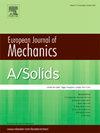Dragonfly-like wing structure enabled by a novel skeleton-reinforced neural style transfer assisted topology optimization and additive manufacturing
IF 4.4
2区 工程技术
Q1 MECHANICS
引用次数: 0
Abstract
Natural flyers, such as dragonflies, serve as excellent models for obtaining wing structures with superior performance due to their excellent mechanical characteristics, motivating the design of bionic structures with similar features. Therefore, this paper proposed a novel skeleton-reinforced neural style transfer assisted topology optimization (SNST-TO) method that integrates density-based topology optimization with a convolutional neural network to impose stylistic feature constraints, while rigorously controlling the minimum length scale using a structural skeleton. The core of this method is the incorporation of geometric skeleton information into the topology optimization process, which prevents unmanufacturable structural features by relying on geometric knowledge rather than solely on pixel similarity. The influence of the key parameters in the algorithm were deeply studied through a series of numerical examples, and the effectiveness and the robustness of the SNST-TO method were completely proved. Furthermore, the dragonfly-like wing structures were designed using the proposed SNST-TO method and commercial software ABAQUS under uniform boundary conditions for clear comparison. Especially, these designs were fabricated using fused deposition modeling additive manufacturing technology and tested through compression experiments in both spanwise and chordwise directions. Results show that the bionic dragonfly wing structure designed using the proposed algorithm outperforms the ABAQUS-optimized structure in mechanical performance, with enhanced spanwise and chordwise load capacities. The findings show that the SNST-TO method facilitates the design of lightweight, load-bearing dragonfly-like wing structures, with potential applications in creating biomimetic structures for other organisms.
一种新型骨架增强神经风格转移辅助拓扑优化和增材制造的蜻蜓状翅膀结构
以蜻蜓为代表的天然飞行物,由于其优异的力学特性,为获得性能优越的机翼结构提供了很好的模型,从而推动了具有相似特征的仿生结构的设计。因此,本文提出了一种新的骨架增强神经风格迁移辅助拓扑优化(SNST-TO)方法,该方法将基于密度的拓扑优化与卷积神经网络相结合,施加风格特征约束,同时使用结构骨架严格控制最小长度尺度。该方法的核心是将几何骨架信息融入到拓扑优化过程中,通过依赖几何知识而不是仅仅依靠像素相似性来防止不可制造的结构特征。通过一系列数值算例,深入研究了算法中关键参数的影响,充分证明了SNST-TO方法的有效性和鲁棒性。在均匀边界条件下,采用所提出的SNST-TO方法和商用软件ABAQUS设计蜻蜓状翼结构,进行清晰对比。特别的是,这些设计采用了熔融沉积建模增材制造技术,并通过跨向和弦向的压缩实验进行了测试。结果表明,采用该算法设计的仿生蜻蜓机翼结构在力学性能上优于abaqus优化结构,具有更强的展向和弦向载荷能力。研究结果表明,SNST-TO方法有助于设计轻质、承重的蜻蜓状翅膀结构,在为其他生物创建仿生结构方面具有潜在的应用前景。
本文章由计算机程序翻译,如有差异,请以英文原文为准。
求助全文
约1分钟内获得全文
求助全文
来源期刊
CiteScore
7.00
自引率
7.30%
发文量
275
审稿时长
48 days
期刊介绍:
The European Journal of Mechanics endash; A/Solids continues to publish articles in English in all areas of Solid Mechanics from the physical and mathematical basis to materials engineering, technological applications and methods of modern computational mechanics, both pure and applied research.

 求助内容:
求助内容: 应助结果提醒方式:
应助结果提醒方式:


